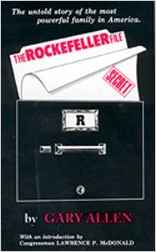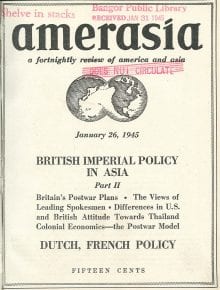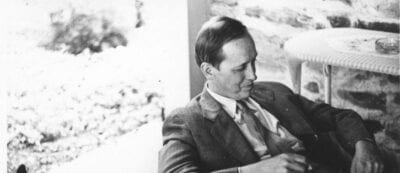you were taught in grade school that Lend-Lease was designed by Franklin D. Roosevelt to arm Britain for the fight against Hitler, since he couldn’t get the U.S. into the war in its first years. Diana West’s research turned up a very different picture where the biggest beneficiary was the Soviet Union hid behind a unique program which bypassed Congress to allow FDR to send arms wherever he thought best. Shortly after Hitler invaded the USSR in June 1941, Lend-Lease began heaving huge amounts of arms, supplies, and even intelligence on the United States at Moscow. West provides evidence that Lend-Lease, besides creating a pipeline in which intelligence on U.S. military and industrial facilities (as well as military arms) could be funneled to the Soviet Union, was also the vehicle for providing American support to the USSR’s nuclear-weapons program – including a shipment of uranium to the Soviets honchoed in 1943 by Harry Hopkins, FDR’s closest adviser during the war.
But Lend-Lease did more than hemorrhage intelligence (and, as West also reports, facilitate the entry of Soviet spies into the U.S). Lend-Lease prioritized massive quantities of arms for the Soviet Union as well – prioritizing them over arms and supplies for U.S. and British forces.
From Diana West’s American Betrayal, p. 43:
War supplies didn’t just “flow” to the Soviet Union, they flooded it, with over half a million trucks and jeeps, nearly $1 billion worth (1940s dollars) of ordnance and ammunition, thousands of fighter aircraft, bombers, and tanks, 13 million pairs of winter boots, 1.7 million tons of petroleum products, a merchant fleet, 1,000 steam locomotives, 581 naval vessels including minesweepers, landing craft, submarine chasers, frigates, torpedo boats, floating dry docks, pontoon barges, river tugs, and a light cruiser. There were also icebreakers, which were essential to keep the northernmost ports of the Gulag Archipelago supplied with fresh slaves, another “lost” fact. American Lend-Lease didn’t just keep the Soviet police state humming along internally, either. As Nikita Khrushchev would say to Life magazine in 1970 of those half a million trucks and jeeps, “Just imagine how we would have advanced from Stalingrad to Berlin without them!”
West’s italics underscore the historical fact that a US government program run by a suspected Soviet agent of influence procured three-quarters of a ton of uranium (including Manhattan-Project-embargoed uranium) and other atomic materials for Stalin. Additionally, as George Racey Jordan writes in From Major Jordan’s Diaries, his memoir of Lend-Lease, “It seems fair to take into account not merely what the Russians got, but what they tried to get.” This was a huge news story in 1950 and then it virtually vanished from our “narrative,” a matter West explores in depth in American Betrayal.
As “19” was attacked (above) to obscure American Betrayal’s widely sourced and -detailed discourse on Harry Hopkins, the new detail under attack is “a” (as in “one”) shipment of uranium. That would seem bad enough, of course. Why was Harry Hopkins’s Lend-Lease scouring all over creation for uranium for Stalin? When Gen. Leslie Groves, head of the Manhattan Project, testified on this subject of uranium shipments to the USSR before Congress in 1949, he could not answer how many shipments of uranium Lend-Lease had in fact transferred to Stalin, because, he said, “we don’t know how many leaked through.”
A Congressional investigation, quoted on p. 124 of American Betrayal – Quoting the March 3, 1950, testimony of 56:
The note is: “Hearings into the Transfer of Atomic Material to the Soviet Union During World War II,” 1149.
A third documented uranium shipment to Stalin went overland in July 1944. An extensive listing of items recorded by Maj. George Racey Jordan, US Army “expediter” of Lend-Lease, who claimed he discovered the following items in a US government-sponsored flight to Russia as it was about to take off from the Lend-Lease hub in Great Falls, Montana.
The list included (p. 123 of American Betrayal):
Road maps … pinpointing American industrial sites (“Westinghouse,” “Blaw-Knox”). Maps of the Panama Canal Zone. Documents related to the Aberdeen Proving Ground, “one of the most ‘sensitive’ areas in the war effort.” Folders stuffed with naval and shipping intelligence. Stacks of papers on oil refineries, machine tools, steel foundries, and the like. Groups of documents on stationery from the Departments of Agriculture, Commerce, and State, “trimmed close to the text,” Jordan noted, perhaps to save weight–or remove “Secret” or “Restricted” stamps (or both). Folders from the State Department Jordan claimed were marked “From Sayre”–that would be Francis Sayre, who hired Alger Hiss–and “From Hiss,” Soviet spy Alger Hiss himself. Engineering and scientific treatises that “bristled with formulae, calculations and professional jargon.” Something very, very interesting I will describe a little farther down attached to a thick map bearing the legend that Jordan recorded as “Oak Ridge, Manhattan Engineering District” (remember, this was taking place sometime in the winter of 1943-44, before the invention, or public knowledge, of the atomic bomb). He also found a carbon copy of a report from “Oak Ridge” containing a series of “outlandish” words Jordan made a note to look up later: “cyclotron,” “proton,” “deuteron.” There were also “curious” phrases, he wrote, “energy produced by fission” and “walls five feet thick, of lead and water, to control flying neutrons.”
Then, Jordan writes, “For the first time in my life, I met the word ‘uranium.’ “
The list had nothing to do with uranium or Hopkins, rather to the fact that three Soviet assets–Hammer, Hopkins and White–got Lend-Lease off the ground in the first place.
In 1949, after Stalin exploded an atomic bomb, former US Army Lend-Lease “expediter” Major George Racey Jordan went public with his claim that he had shipped uranium to the Russian during World War II, and that Harry Hopkins was personally involved. Groves had no idea the Manhattan Project’s embargo had been broken until Jordan spoke up. What West does in American Betrayal is weigh Jordan’s testimony and reports, explain what aspects of his story have been corroborated and what have not. She examines Congressional investigations, histories, memoirs and the like. She pays close attention, for example, to the case of the great Soviet defector Victor Kravchenko, author of I Chose Freedom, who defected from the Soviet Lend-Lease office in Washington, DC. Jordan and Kravchenko had worked on opposite sides of Lend-Lease during World War II, but in dramatic testimonies before Congress after the war they would confirm relevant sections of each other’s stories.
 Author Diana West outlines how aircraft and munitions flowed uninterrupted to the Soviets during the Battle of the Philippines in late 1941 and 1942, when Douglas MacArthur needed but could not get air reinforcements, and eventually had to evacuate, leaving the U.S. protectorate of the Philippines to its fate. Indeed, in the fall of 1941, a big shipment of 200 aircraft that was intended for the British forces defending Singapore was diverted to the Soviets in the Lend-Lease pipeline, along with a shipment of tanks. Singapore fell to the Japanese in February 1942. It was Harry Hopkins, Armand Hammer, and Harry Dexter White who got Lend-Lease going in the first place–a trio of veritable Soviet assets. From Hammer to Hopkins to White and back again to Hopkins: The question now becomes, How could Lend-Lease not have been a rogue operation?
Author Diana West outlines how aircraft and munitions flowed uninterrupted to the Soviets during the Battle of the Philippines in late 1941 and 1942, when Douglas MacArthur needed but could not get air reinforcements, and eventually had to evacuate, leaving the U.S. protectorate of the Philippines to its fate. Indeed, in the fall of 1941, a big shipment of 200 aircraft that was intended for the British forces defending Singapore was diverted to the Soviets in the Lend-Lease pipeline, along with a shipment of tanks. Singapore fell to the Japanese in February 1942. It was Harry Hopkins, Armand Hammer, and Harry Dexter White who got Lend-Lease going in the first place–a trio of veritable Soviet assets. From Hammer to Hopkins to White and back again to Hopkins: The question now becomes, How could Lend-Lease not have been a rogue operation?
FDR told U.S. Treasury Secretary Henry Morgenthau in March 1942 – incident to an appeal from MacArthur for support to the U.S. and Filipino troops fighting on Bataan and Corregidor – that he “would rather lose New Zealand, Australia, or anything else than have the Russian front [i.e., the front with Hitler in the western Soviet Union] collapse.”
Was the Russian front in danger of collapsing? That’s a good question; by March 1942, Soviet troops had pushed the Germans back from Moscow and had them retreating toward Vitebsk, Smolensk, and Kursk along the northern portion of the front. Later, in August 1942, the Germans would launch Operation Blue and drive to their furthest point of advance into the Caucasus – almost to Grozny, in Chechnya – in the south. (The Battle of Stalingrad was part of this advance.) Hitler hoped to secure the Caucasus oilfields with this move, recognizing that with the United States in the war, his link to North Africa could be in increasing peril. (American troops landed in North Africa in November 1942.)
The NKVD did have a line of sorts into Lend Lease for real. Over security objections of both the State and War Departments and Army chief of staff Gen. George C. Marshall, Hopkins insisted on elevating Army officer Philip Faymonville, a.k.a. the “Red Colonel,” to run Lend-Lease in Moscow. There, Soviet records show, Faymonville was recruited by the NKVD in 1942. NKVD recruit Faymonville would help run–“orchestrate?”–Lend-Lease for the duration.
If there is a weakness in West’s treatment of her topic, it lies in the fact that she doesn’t fully address the war context in which FDR was making decisions (or, at least, his advisors were). She makes a very commendable effort to do just that regarding some of her points; e.g., regarding the Allied decision to conduct the D-Day invasion. On the question of how close the Russian front was to “collapse,” however, the book doesn’t outline a context for making that assessment in early 1942.
Stipulating that hindsight is not available to decision-makers, we can note that Soviet forces, reinforced from the Far East, and having received Lend-Lease supplies for at least six months at that point, had been able to mount a successful counteroffensive on the most strategically important 300-mile stretch of an 800-mile front. Moscow was in no danger of falling, by March 1942; whether any portion of the Soviet front line was in danger of “collapsing” – or, indeed, what FDR even meant by those words – is harder to say.
But West got pushback on her book, from knowledgeable people of goodwill who have lived for many years with the standard narrative of World War II in their heads. If FDR prioritized supplying the Soviets over supplying U.S. and British forces in Southeast Asia, they will say, that was because of his war strategy: a strategy we have long known about and recognized as part of the narrative. What’s the big deal? Yes, we knew FDR decided to focus our effort on the European front first. Analysts and historians have been thrashing out the question of whether he should have for decades. Does West’s book add anything new?
Sources: https://www.breitbart.com/politics/2013/09/10/the-rebuttal-part-three/
Chronological History of Events Related to Lend-Lease

‘The Rockefeller File’ by Gary Allen is Published

The Vietnam War Begins (Unofficially), but Why Would America get Involved in this Needless War?

The Korean War: Another War that Served the Illuminati Agenda, but this Time Under the Control of the Communist United Nations

At the Opening of the Chinese People’s Political Consultative Conference in Peking, Mao Zedong Outlines the New Chinese Communist Government – Thanks to U.S. Assistance!

The US Army Signal Intelligence Service (NSA forerunner) Begins the VENONA Project to Examine Encrypted Soviet Communications




